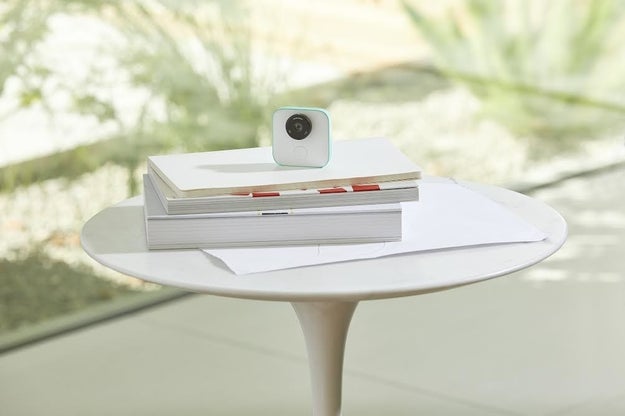Designed for parents and pet owners, it’s meant to help you capture candid moments.
This is Google’s new camera. It’s called Google Clips.

It's entire purpose is to automatically take candid photos of hard-to-capture subjects like kids or pets.
It's quite small, sort of cute, and is basically a cube with a big lens in the front. There is no display, or viewfinder, and it is meant to be used hands-free via an attached clip that doubles as a stand. It costs $249 and will work with iOS 10 and Android 7 or later. There's no ship date yet.
Yeah, so, here's where the camera gets weird.
The camera uses artificial intelligence to both evaluate picture quality and see if someone it “knows” is within view. If it decides that something is a good picture and it recognizes the subject (which could be a person or a pet), it takes a short clip — which can be saved as a video, a GIF, or as one of Google's newly-announced Motion Photos. You can also select still images if moving pictures are not really your thing.
It saves a stream of these photos to its internal memory. Then, it connects wirelessly to your phone and a new app called Clips shows a feed of “suggested clips.” You then have the option to save these, or delete them. (You can also set it to save all the suggested clips if you want.) You have the option to export photos to third party apps, like email or Instagram.
It is important to stress here that the camera isn't continually shooting and saving pictures, or taking them at set intervals. Rather, it is making value judgments about the shots it selects. It effectively acts as a personalized photo editor.
Google says it wanted to automate the process of both capturing and selecting great images. Which means it wanted to alleviate the tedious process of flipping through lots of shots to find a good one, or scrolling through video to find the perfect moment. So it evaluates those photos on the device as they happen to determine what to save to memory. What's more, it's taking more pictures than it shows you in suggested clips. You can can toggle a switch to see all the photos it takes. The suggested ones are the clips that the camera has judged to be delightful enough to rise to your attention.
Juston Payne, the product lead for Clips, told BuzzFeed News that the camera looks at many different elements in a clip to make those calls. It wants to see if the shot is stable and well lit. It looks for clips where people are smiling and have their eyes open. It has a bias for jumps and motion that indicate action. And most importantly, it has face detection that looks for a familiar face. (There are dog and cat classifiers too, Google says.)
Blaise Aguera y Arcas, a principal scientist with Google's machine intelligence, says that the camera is powered by neural nets that were trained by human curators. (In essence, people helped the camera's machine learning software understand what makes a good shot.) When it matches the attributes of a good shot with a subject it knows, it shows you that clip.
Aguera y Arcas predicts that, going forward, the Clips cameras will begin to learn what types of photos specific people love. “That's very much our hope, where we can develop modes based on people's tastes.”
What's also compelling about this, from both a privacy and performance perspective, is that all this happens in the camera itself.
Traditionally, pulling off this kind of image selection and processing would have had to take place “on a bank of desktops somewhere with powerful GPUs”, Aguera y Arcas told BuzzFeed News. “This is the first moment that it could plausibly be done on the device,” he said. “It was a process of getting a chip specifically designed to run neural nets at very low power.”
And because this happens in the camera, it means that it can get better battery performance than it would if it were processing in the cloud. It doesn't expend resources transferring data to and from a remote server to be processed.
(Google claims three hours; we found it to be better than two but not up to three on a prototype running beta software.)
Also, on-device AI means that if your camera automatically captures an embarrassing moment, you can kill it before it anyone else ever sees it. For example, the photo of my kid playing in the sprinkler was cute, true, but you could really see my back fat where I was bending over in the corner of the shot. Deleted!
There are several things Google did here to address privacy. For starters, it's offline. The photos are only stored on the device, unless you connect it to your phone and move them over (or set it to automatically do that). This means you have the chance to locally review everything it has shot. There's also a pulsing LED light that shows when it is active.
And finally, Clips purposefully looks familiar. Payne says Google wanted it to be instantly recognizable as a camera, and that “we were trying not to make it feel too much like a tech product.” If someone else is wearing it clipped on their clothes, for example, you would immediately recognize that this thing is a camera and that it's maybe capturing your picture.
Quelle: <a href="Google's New Camera "Clips" Uses AI To Automatically Get Great Shots“>BuzzFeed
Published by